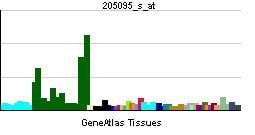Entrez 535 | Ensembl ENSG00000033627 | |
 | ||
Aliases ATP6V0A1, Atp6v0a1, AA959968, ATP6a1, Atp6n1, Atp6n1a, Atpv0a1, Vpp-1, Vpp1, Stv1, Vph1, a1, ATPase, H+ transporting, lysosomal V0 subunit a1, ATP6N1, ATP6N1A, VPP1, ATPase H+ transporting V0 subunit a1 External IDs MGI: 103286 HomoloGene: 3795 GeneCards: ATP6V0A1 | ||
V-type proton ATPase 116 kDa subunit a isoform 1 is an enzyme that in humans is encoded by the ATP6V0A1 gene.
This gene encodes a component of vacuolar ATPase (V-ATPase), a multisubunit enzyme that mediates acidification of eukaryotic intracellular organelles. V-ATPase dependent organelle acidification is necessary for such intracellular processes as protein sorting, zymogen activation, receptor-mediated endocytosis, and synaptic vesicle proton gradient generation. V-ATPase is composed of a cytosolic V1 domain and a transmembrane V0 domain. The V1 domain consists of three A and three B subunits, two G subunits plus the C, D, E, F, and H subunits. The V1 domain contains the ATP catalytic site. The V0 domain consists of five different subunits: a, c, c', c", and d. Additional isoforms of many of the V1 and V0 subunit proteins are encoded by multiple genes or alternatively spliced transcript variants. This gene encodes one of three A subunit proteins and the encoded protein is associated with clathrin-coated vesicles. The occurrence of splice variants encoding different protein products has been reported, but the full-length natures of these transcripts have not been determined.
